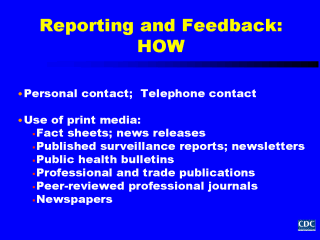Search for most updated materials ↑
 |
 |
front |1 |2 |3 |4 |5 |6 |7 |8 |9 |10 |11 |12 |13 |14 |15 |16 |17 |18 |19 |20 |21 |22 |23 |24 |25 |26 |27 |28 |review |
 Now that we’ve talked about some of the groups who should receive feedback on surveillance information and the kind of information that would be useful to them, let’s talk about some of the ways in which you can provide this information. Providing information during visits to health care providers' offices, schools, worksites, and other settings is particularly effective as the individual interaction and opportunity for face-to-face communication allows people to receive immediate feedback to questions and concerns. Telephone calls to these same settings can serve a similar function. Given that it is difficult and time consuming to make in-person visits and/or telephone calls to all the individuals and groups who provide you with surveillance data, alternative means of information dissemination can be used as well. Traditionally, different forms of print media have been used. These include: - fact sheets and news releases, - published surveillance reports and newsletters of local and state medical and public health societies, - public health bulletins, - professional and trade publications, - professional journals, and newspapers. |
 |
 |
front |1 |2 |3 |4 |5 |6 |7 |8 |9 |10 |11 |12 |13 |14 |15 |16 |17 |18 |19 |20 |21 |22 |23 |24 |25 |26 |27 |28 |review |